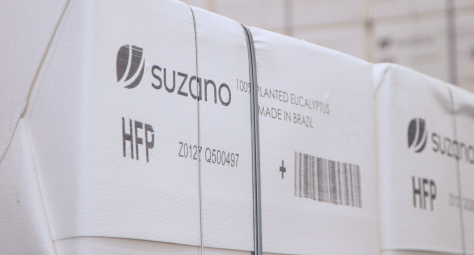sobre o que você deseja falar?


perguntas, sugestões ou problemas técnicos envolvendo a plataforma

informações sobre a empresa






Dimensão SASB
Energy ManagementCódigo SASB
RR-PP-130a.1Código SASB
RT-CP-130a.1Setor SASB
Pulp & Paper ProductsSetor SASB
Containers and PackagingDimensão GRI
EnvironmentalCódigo GRI
302-1Código GRI
302-2Código GRI
302-4Suzano's energy matrix is predominantly made up of renewable sources, the main one being wood-based biomass. This biomass can be in liquid form, such as black liquor, or made up of waste, such as wood bark, logs, chipping residues, and even the reuse of biological sludge generated in the pulp production process.
Suzano is self-sufficient in electricity and is among the largest self-producers in Brazil, generating from renewable sources. In some of its units, there is a surplus of electricity production, allowing it to be made available to the National Interconnected System (SIN), thus increasing the share of renewable sources in the Brazilian electricity matrix.
In 2024, the company expanded its industrial operations with the completion of the Cerrado Project, located in Ribas do Rio Pardo (MS). This new unit was initially connected to the SIN as an energy consumer. Once operating at full capacity, it began to contribute renewable energy to the national grid.
With this unit, Suzano is increasing the energy generated from renewable sources available to the Brazilian grid by an average of 105 MW, enough to supply approximately 1 million inhabitants annually. In line with its commitment to sustainability, the company is working to increase its exports of renewable electricity by 50% by 2030, contributing to the energy transition and expanding the use of clean sources in the country.
The company's strategy is focused on reducing the consumption of non-renewable fuels and seeking energy efficiency in its operations. In 2024, initiatives such as using machine learning to balance electricity generation and fossil fuel consumption stood out. This project showed significant results at the Aracruz (ES) plant during the year, reducing natural gas consumption. Another mechanism implemented was the optimization of the use of methanol in furnaces and boilers, contributing to the efficiency of industrial processes, the reduction of natural gas consumption, and the prevention of waste.
In line with its commitments to sustainability and the transition to an increasingly renewable energy matrix, Suzano took essential steps in 2024 with the start of operations at the gasification plant in Ribas do Rio Pardo and the use of soybean vegetable oil as a boiler fuel at the Três Lagoas (MS) unit.
The gasification plant represents a milestone in diversifying our renewable energy sources. This innovative technology converts biomass into clean and efficient combustible gas, which can be used directly in industrial processes, strengthening the unit's energy self-sufficiency.
At the same time, the Três Lagoas plant has successfully started using soy vegetable oil in its boilers. Produced from renewable natural resources, this oil reduces carbon emissions and fine particles, which aligns with our objectives of mitigating environmental impacts and promoting cleaner operations.
The increase in Suzano's energy consumption is directly related to the expansion of its industrial operations, driven by the start-up of the Cerrado Project, which increased the energy demand needed to support the new production unit.
The main fuels used in forestry and logistics operations continue to be diesel oil, gasoline, and liquefied petroleum gas (LPG). In 2024, the composition of diesel oil changed to 14% renewable biodiesel and 86% fossil diesel, as determined by the government in Law No. 14.993/24 (Fuel for the Future Law).
The primary energy demands external to the organization are related to the consumption of fuels used in transporting and distributing inputs and products, both domestically and abroad. This also includes the transportation of employees and waste. Energy-related information is obtained from Suzano's Greenhouse Gas Inventory.
The following information is available in the tables below:
| 2020 | 2021 | 2022 | 2023 | 2024 | |
|---|---|---|---|---|---|
|
Fuel from non-renewable sources |
28.024.857,22 |
30.956.553,51 |
29.832.586,94 |
29.095.141,02 |
30.054.352,61 |
|
Fuel from renewable sources |
214.386.646,59 |
216.528.216,90 |
217.504.399,00 |
211.172.499,54 |
232.494.073,77 |
|
Energy consumed |
3.498.800,20 |
3.872.202,27 |
4.148.649,19 |
4.208.093,25 |
5.782.512,14 |
|
Energy sold |
5.646.273,28 |
5.711.287,89 |
5.435.818,50 |
4.786.387,51 |
5.476.315,98 |
|
Total Amount |
240.264.030,73 |
245.645.684,79 |
246.049.816,84 |
239.689.346,30 |
262.854.622,54 |
| 2020 | 2021 | 2022 | 2023 | 2024 | |
|---|---|---|---|---|---|
|
Liquefied petroleum gas (LPG) |
446.402,25 |
1.092.385,52 |
537.155,70 |
501.524,67 |
500.354,29 |
|
Natural gas |
20.258.553,43 |
21.648.153,04 |
19.512.161,44 |
19.527.866,04 |
17.529.062,41 |
|
Gasoline¹ |
59.317,87 |
40.571,86 |
94.029,43 |
92.785,41 |
110.326,22 |
|
Greases and lubricants² |
301.343,39 |
252.466,91 |
0,00 |
0,00 |
0,00 |
|
Fossil methanol |
0,00 |
0,00 |
0,00 |
0,00 |
0,00 |
|
Heavy fuel oil |
2.811.666,29 |
3.380.402,50 |
3.401.526,38 |
3.133.902,09 |
5.103.793,18 |
|
Diesel oil - road³ |
3.861.967,58 |
4.514.178,48 |
6.287.714,00 |
5.839.062,81 |
6.810.816,51 |
|
Diesel oil - maritime⁴ |
285.606,42 |
28.395,20 |
0,00 |
0,00 |
0,00 |
|
Total amount |
28.024.857,23 |
30.956.553,51 |
29.832.586,94 |
29.095.141,02 |
30.054.352,61 |
| 2020 | 2021 | 2022 | 2023 | 2024 | |
|---|---|---|---|---|---|
|
Anhydrous ethyl alcohol |
21.939,49 |
15.006,03 |
12.346,00 |
17.758,86 |
28.249,72 |
|
Hydrated ethyl alcohol |
389.714,38 |
10.640,54 |
34.778,00 |
35.194,46 |
40.046,47 |
|
Biodiesel (B100) |
493.634,95 |
585.642,26 |
698.634,89 |
713.578,14 |
1.059.610,30 |
|
Biomass |
14.501.384,42 |
12.244.044,40 |
13.712.332,41 |
14.761.335,52 |
15.612.971,26 |
|
Black liquor (lye) |
196.843.955,86 |
201.368.450,59 |
200.809.882,36 |
193.738.966,93 |
213.502.241,91 |
|
Methanol renovavel |
2.136.017,49 |
2.304.433,07 |
2.236.425,44 |
1.905.665,63 |
2.250.954,11 |
|
Total amount |
214.386.646,59 |
216.528.216,90 |
217.504.399,21 |
211.172.499,54 |
232.494.073,77 |
| 2020 | 2021 | 2022 | 2023 | 2024 | |
|---|---|---|---|---|---|
|
Electricity |
3.498.800,20 |
3.872.202,27 |
4.148.649,19 |
4.208.093,25 |
5.782.512,14 |
|
Heating |
0,00 |
0,00 |
0,00 |
0,00 |
0,00 |
|
Refrigeration |
0,00 |
0,00 |
0,00 |
0,00 |
0,00 |
|
Steam |
0,00 |
0,00 |
0,00 |
0,00 |
0,00 |
|
Total amount |
3.498.800,20 |
3.872.202,27 |
4.148.649,19 |
4.208.093,25 |
5.782.512,14 |
| 2020 | 2021 | 2022 | 2023 | 2024 | |
|---|---|---|---|---|---|
|
Electricity |
5.646.273,28 |
5.711.287,89 |
5.435.818,51 |
4.786.387,51 |
5.476.315,98 |
|
Heating |
0,00 |
0,00 |
0,00 |
0,00 |
0,00 |
|
Refrigeration |
0,00 |
0,00 |
0,00 |
0,00 |
0,00 |
|
Steam |
0,00 |
0,00 |
0,00 |
0,00 |
0,00 |
|
Total amount |
5.646.273,28 |
5.711.287,89 |
5.435.818,51 |
4.786.387,51 |
5.476.315,98 |
| 2020 | 2021 | 2022 | 2023 | 2024 | |
|---|---|---|---|---|---|
|
Total amount |
20.508.581,65 |
24.608.503,50 |
23.414.086,00 |
23.597.073,86 |
32.227.112,14 |
The measurements are collected automatically from Suzano's internal systems and, in some cases, are converted into units of measurement. The fuel consumption data was converted into energy consumption based on each fuel's essential density and lower calorific value. To this end, the data contained in the technical specifications sheet of the fuel used was used when available. When unavailable, we used the figures from the National Energy Balance [Ministério de Minas e Energia (MME), 2021].
To learn more about energy management at Suzano, go to “Energy management”.